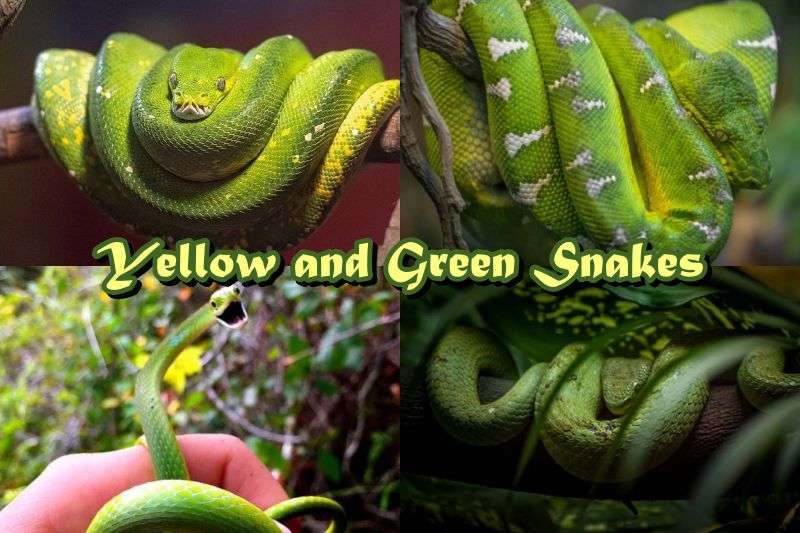Snakes are one of the most morphologically diverse creatures on the planet. With a body covered with scales, their body coloration varies with every species and individual.
From black to brown to red to yellow, snakes come in almost all colors from an artist’s palette.
While some are venomous, others are non-venomous. In today’s article, we have mentioned 10+ Types of Yellow and Green Snakes Worldwide. So, without further ado, let’s get going with our write-up.
Types of Yellow and Green Snakes
1. Emerald Tree Boa
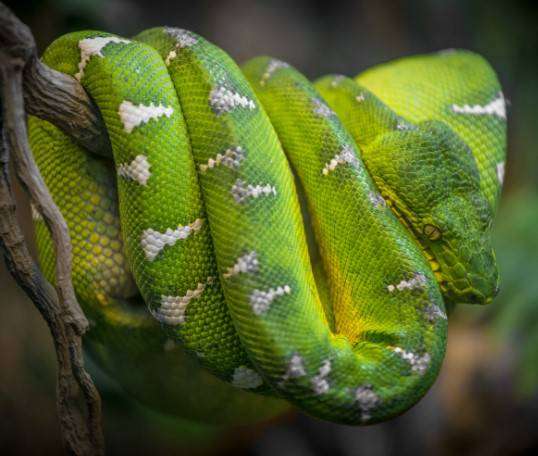
The common color pattern is an emerald green base color with so-called “lightning bolts” or an uneven white zigzag streak along the back. The belly is generally yellow.
The vivid coloring and markings make South American snakes easily identifiable. They prefer to be alone themselves. Emerald tree boas seek prey in ambush at night. They wait patiently on a limb above the ground, ready to attack any little rodents who pass beneath them without thinking.
- Scientific name: Corallus caninus
- Size: 6 feet (1.8 meters)
- Location: South American Rainforests
- Diet: arboreal rodents, squirrels, monkeys, lizards, and bats
2. Green Tree Python

Green tree pythons resemble an unrelated relative from South America, the emerald tree boa, in appearance and behavior. The phenomenon they exhibit is Parallel evolution.
Large, diamond-shaped head, distinct from the neck, the head is one of its characteristics. The snout is broad and pointed. The adults’ vivid green color aids in hiding them amid the tall trees’ leaves.
Small mammals and reptiles make up the majority of the green tree pythons’ diets. These pythons hunt by sight and detect an animal’s thermal image via the labial pits.
- Scientific name: Morelia viridis
- Size: 2 meter
- Location: Indonesia, Papua New Guinea, and Australia
- Diet: mostly small mammals and reptiles
3. Eastern Green Mamba
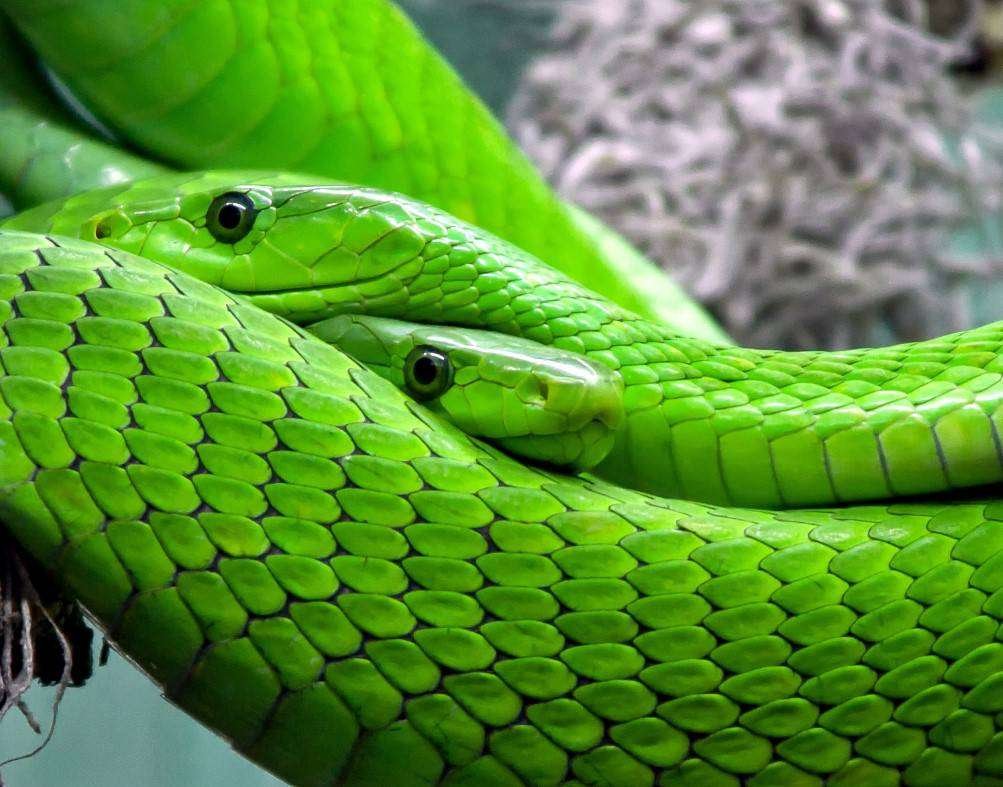
Next up, in this list of Yellow and Green Snakes, we have the Eastern Green Mamba. The Green Mamba is a slim animal with a back that is vivid green and ventral scales that are greenish-yellow in color.
The Eastern Green Mamba is a timid and elusive animal with a few spots here and there. Its arboreal habitat and green hue, which serves as camouflage in its natural environment, are typically credited with this nature of theirs, quite different from other “Elapids.”
In addition to mice, rats, and other rabbits, it also preys on birds, bats, etc. Its venom is highly potent, possessing both neurotoxins and cardiotoxins.
- Scientific name: Dendroaspis angusticeps
- Size: up to 2 meters
- Location: Southern East Africa’s coastal regions
- Diet: birds and their eggs, and small mammals including bats
4. Rough Green Snake
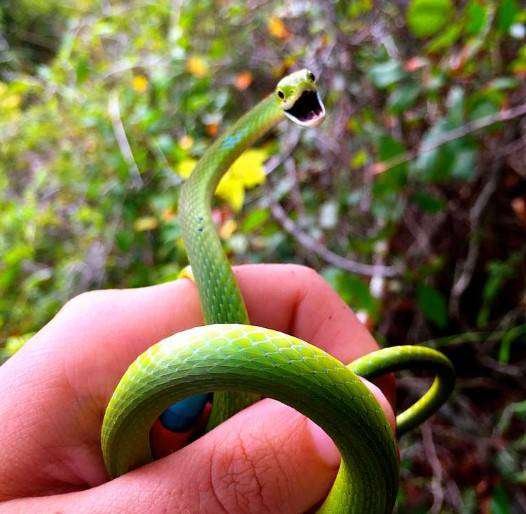
The rough green snake has emerald green-colored scales on their bodies, with yellow skin down their sides and yellowish skin all along their bellies. Because of its vivid coloration, the rough green snake can blend in perfectly with the surrounding greenery.
Most of the time, rough green snakes—who are perhaps the most arboreal in its area—are out looking for insects and other invertebrates, like spiders. Rough green snakes are non-venomous creatures.
- Scientific name: Opheodrys aestivus
- Size: up to 1 meter
- Location: Southeastern United States
- Diet: insects such as crickets, caterpillars and grasshoppers
5. Green Tree Snake
The Green Tree Snake is a diurnal, slim snake with big eyes and is not poisonous species. A common snake, one can easily identify it by its cream-to-yellow belly. A prominent wide dark facial stripe runs across the eye.
They inhabit a wide range of environments, including open forests and urban and agricultural areas. Green Tree Snakes frequently like the shade of tiny plants and trees’ leaf canopies and can quickly flee through them. They consume reptiles and frogs.
- Scientific name: Dendrelaphis calligastra
- Size: 1.2 meter
- Location: Indonesia, Australia, and New Guinea
- Diet: frogs, skinks, geckos, lizards, reptile eggs, small mammals, stranded tadpoles and fish
6. Green Keelback
The next species in this list of Yellow and Green Snakes is the Green Keelback. A non-venomous species, the Green Keelback has a stocky body, which quite resembles a viper. The dorsal side of the body is a bright green color with irregular or prominent black stripes.
The underside or the belly region is yellowish to light green. Juvenile Keelbacks have a more vibrant coloration, with a V-shaped Black color on the head, followed by a bright yellow mark. They feed primarily on amphibians like toads and amphibians.
- Scientific name: Macropisthodon plumbicolor
- Size: 2 feet
- Location: Sri Lanka and Peninsular India
- Diet: mice, lizards, birds, insects, fish and frogs
7. Greater Green Snake
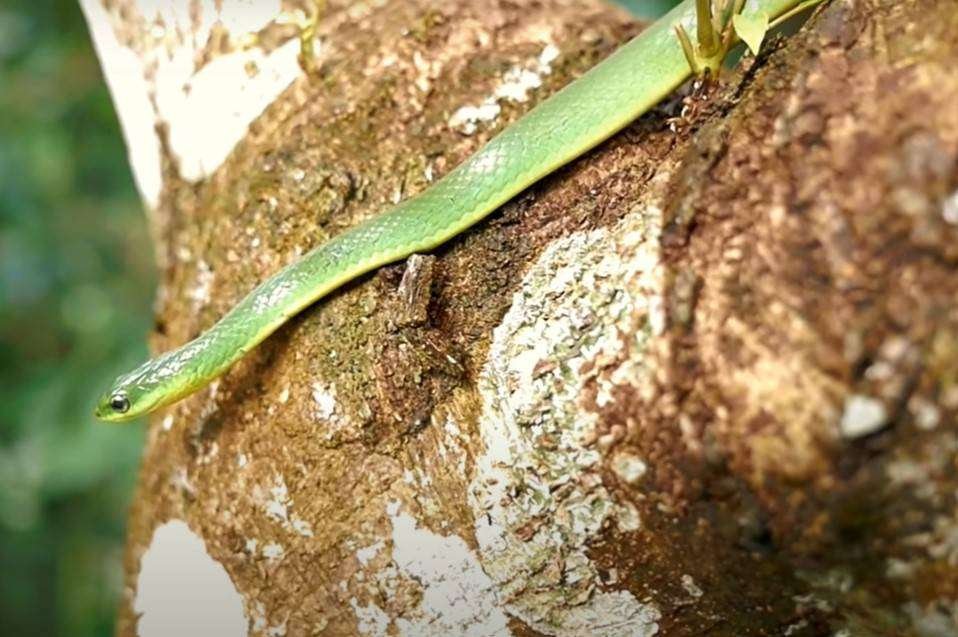
If you have ever been to the wilds of Hong Kong, I’m sure of your encounter with the Greater Green Snake or the Chinese Green Snake. All Greater Greens are bright green on top with yellow bellies, with hardly any color variation.
Greater Greens are diurnal creatures, pursuing a variety of prey, but because they predominately feed on earthworms, they must spend quite a significant time on the ground.
They seldom bite and are calm when confronted. Chinese Greens can be found in practically any place there is water, foliage, leaf litter, or decaying logs due to their worm-based diet. You can also watch this video to get a better understanding.
- Scientific name: Ptyas major
- Size: 2.5-3 feet
- Location: China, Taiwan, Hong Kong
- Diet: insects and worms
8. Indian Green Pit Viper

The next Green and Yellow Snake is the Indian Green Pit Viper. With heat-sensing pits between the eyes and nostrils, the triangular head is substantially wider than the neck.
The dorsal side is mainly green with sporadic, barely perceptible black patterns. The abdominal area is yellowish on the underside.
Indian Green Pit Vipers conceal themselves among thorny plants and tree cavities. They are nighttime, tree-dwelling snakes that prey mostly on frogs, reptiles like lizards, and rodents like mice.
- Scientific name: Trimeresurus gramineus
- Size: 2 feet
- Location: India
- Diet: Lizards, birds, and tree frogs
9. Malayan Green Whip Snake
Quite a new inclusion to the Vine Snake genus, the Malayan Green Whip Snake bears a vibrant dorsal coloration. The sides have a yellowish to light greenish coloration, with a white underside.
The Malayan Green Whip Snake is slightly poisonous yet docile. We may encounter them in primary and secondary forests and are frequently seen on vegetation next to a water body like a forest stream.
- Scientific name: Ahaetulla mycterizans
- Size: up to 1 meter
- Location: Malaysia, Sumatra
- Diet: frogs and lizards
10. Wagler’s Pit Viper
The Wagler’s Pit Viper has a very thin body and a huge, triangular-shaped head. It nearly exclusively lives in trees, and its prehensile tail helps it ascend. It comes in a wide range of hues and patterns that are frequently referred to as “phases”; some experts refer to them as sub-species.
The hue of the phases varies widely, with some having a base color of black-brown with orange and yellow striping and others having a base color of pale green with yellow or orange banding, among many other variants.
T. wagleri’s venom is haemotoxic. Although the bite is not considered lethal, it may result in excruciating agony and small-area edema.
- Scientific name: Tropidolaemus wagleri
- Size: 1 meter (females), 75-80 centimeter (males)
- Location: Vietnam, Malaysia
- Diet: rodents, birds, and lizards
11. Green Cat Snake
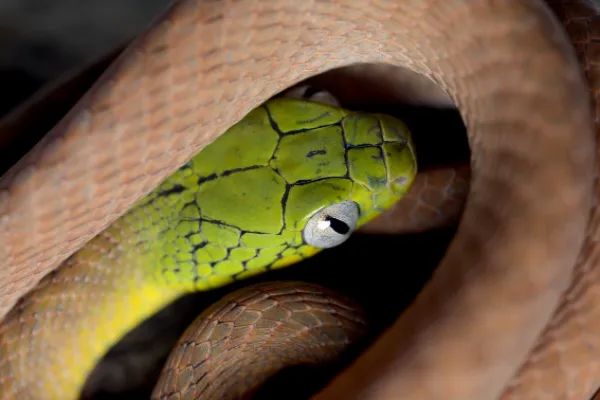
Another beautiful green and yellow snake is Green Cat Snake which is found in South Asia, China, and Southeast Asia.
This snake is primarily in green color with a yellowish-white belly and golden-brown eyes.
Green Cat Snakes are arboreal snakes that mainly hunt during the night. These snakes are non-venomous and bite can cause mild pain and swelling.
- Scientific name: Boiga cyanea
- Size: up to 190 cm
- Location: Bangladesh, Bhutan, Cambodia, China (Yunnan- part), India (Sikkim, Darjeeling & Jalpaiguri, West Bengal, Assam, Arunachal Pradesh, Andaman & Nicobar Islands), Laos, Malaysia (West), Myanmar, Nepal, Thailand (incl. Phuket) and Vietnam.
- Diet: lizards, frogs, birds, rodents, and other small snakes
Other Green and Yellow Snakes
-
12. Philothamnus nitidus
-
13. Plains Garter Snake
-
14. Red Tailed Green Ratsnake
-
15. Green Anaconda
-
16. Blue Green Tree Python
-
17. Neonate Green Tree Python
-
18. Biak Green Tree Python
-
19. Green Blotch Corn Snake
-
20. Natal Green Snake
-
21. Chinese Green Bamboo Pit Viper
-
22. Bronze Headed Vine Snake
-
23. Gunther’s Vine Snake
-
24. Yellow Green Cat Snake
Frequently Asked Questions
Q1. Name of Green and Yellow snakes found in Texas?
Ans. Smooth Green Snakes, Rough Green Snakes are the two Green and Yellow Snakes found in Texas.
Q2. Are Green and Yellow snakes venomous?
Ans. No, all Green and Yellow snakes are not venomous. While some species are venomous or mildly venomous, there do exist non-venomous species.
Venomous species include the Eastern Green Mamba, Green Pit Vipers, and Wagler’s Pit Viper while examples of non-venomous species are Emerald Tree Python, Green Tree Python, Green Tree Snake, etc.
Q3. Name of Green snakes with Yellow stripes (or green and yellow striped snakes)?
Ans. Wagler’s Pit Viper is a Green Snake with Yellow stripes.
Here, we conclude our today’s article, 10+ Types of Yellow and Green Snakes Worldwide. Hope it has quenched your curiosity, so next time you can identify it if you encounter one in the world. We will be back with our next article soon. Until then, please do visit our other articles on snakes only on this website.
References
- Thai National Parks- Species of Thailand- Wagler’s palm pit viper
- Smithsonian’s National Zoo and Conservation Biology Institute- Green Tree Python
- Hongkongsnakeid.com- Greater Green Snake
- iNaturarist- Bamboo Viper
Also Read:

A zoology student turned writer. Nature has always been a magnet to me, and to unearth some of its secrets through my articles is my prime intention. If not engaging myself with nature and anime content, you can always find me going through some Bengali classics or filling the air with some soulful Tabla beats. An artist, trying to throw some colors to my blank canvas of life.
